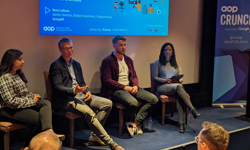In November last year, I oversaw the relaunch of the Peak Performance website, www.pponline.co.uk, as a "Web 2.0" site complete with all the bells and widgets that define such sites: community, user generated content, interactivity, video and a fresh modern look. I wrote about the thinking behind the relaunch in the November / December 2007 issue of InCirculation, just before we went live. I approached the day of the relaunch with the excitement and trepidation that accompanies any big event; the last hours involved me literally breathing down the necks of our web developers (I’m sure they enjoyed it). And then we pushed the button and unleashed our new-look baby on an unsuspecting world.
So how did it all go? In this follow-up article, I’m going to explain what worked well, what didn’t go so well, what we learned and where our thinking went next.
Also, this year, we have launched a premium area of the site, available only to paying subscribers, and I am going to look at how that’s going and how the two areas – free and paid – work together.
Previously on Peak Performance…
In its 1.0 incarnation, Peak Performance was a text-only site for athletes containing a large library of free articles, well-optimised for search engines to pull in traffic and capture their email addresses for our marketing, with the aim of selling subscriptions to our newsletters. We had grown to 400k unique visitors a month and were very successful at getting leads, but we had plateaued and the site looked dated. Listed here are the aims of the redevelopment with an update on what’s happened:
* Move away from text only, as users demand more: video, audio, tools.
YouTube can breathe easy. The text pages are still by far the most popular on the site. It seems that we over-estimated the demand for video among our users. I still believe that our subject matter – training for sport – lends itself to video, and our experience on the new premium area of our site (see below), backs this up. The lesson is that video for video’s sake adds very little. Listing isolated video clips doesn’t work. So the next stage will be to use video to enhance our core content, with embedded clips within articles only where they add to the text. Audio and tools will be used in the same way.
* Create a sticky community site with interwoven stranded marketing.
We went live with an array of community features: groups, member pages with Facebook-esque walls where members could leave messages for one another, blogs, comments, a forum, and a question and answer section. We quickly discovered that by providing so much, we gained very little. We spread ourselves too thin and the visitors didn’t understand how they could use the site. The member walls were most used by people leaving customer service enquiries! The groups failed to meet the dictionary definition of that word.
The lesson is to focus on one thing at a time. The most popular feature – though still underpopulated initially – was the Q&A section, where visitors could post and answer questions. We started to promote this feature ahead of all other community features, redesigning it to make it easier to use, mailing our database about it and announcing a points system. Users could earn points to spend in our shop by asking and answering questions. Suddenly, it took off, and we now have a thriving section of the site. The other community features are being scaled back and rethought, while more effort will be put into growing the Q&A section with the aim of making it the first place sportspeople go when they need help. Part of this will include getting our in-house experts to host Q&A sessions, all free, with the ultimate goal of selling a subscription.
* Allow users to generate their own content.
For us, the biggest benefits of user generated content are firstly, more keyword-rich pages for search engines that don’t cost us a penny to produce and, secondly, a stickier site and more engaged users.
We almost immediately gave up on user-generated video because of the quality of the stuff we received, most of it pretty random and not sport related. (Not sport in the strictest sense, anyway!) However, the aforementioned Q&A pages have added substantially to the size and stickiness of the site. We go through the pages and optimise them afterwards, adding targeted keywords to the titles and amending prominent spelling mistakes, and we have appointed moderators in the community to keep an eye on things and make sure the quality of information stays high. These moderators are volunteers; unless you have a lot of resource, this is the best way to police a community.
We have also seen some success with blogs. We started with our own in-house bloggers, but we now have a number of regular users writing posts which are highly relevant to our visitors. We have some problems with bloggers writing posts purely to promote their own sites or products, but this can actually be a useful method of finding partners and affiliates.
* Make the site better-designed and more advertiser friendly.
In the past, we’ve never had any luck selling advertising on PP Online because the advertisers we approached were sniffy about the way it looked. So one of the aims was to make the site more appealing to advertisers, partly so we were not so reliant on Adsense, which is becoming less lucrative. The reaction we’ve had has been very positive and banner advertising will begin to form a bigger part of our strategy as we move forward.
However, the biggest benefits of the new design have been unexpected:
We have always used our sites to collect leads for our free newsletter, as we sell most subscriptions through our emarketing channel. We saw an immediate, dramatic rise in the number of people signing up to the free newsletter, and I believe this is because the site looks more professional and trustworthy.
Secondly, we were approached by a German publisher who were so impressed by the new site that they have commissioned us to create a German-language version for them. This deal alone has paid for the redevelopment.
* Move away from a reliance on pop-ups and get more valuable registered users.
The bulk of leads collected are through the pop-ups. Everybody in the world hates pop-ups, just like everyone hates TV adverts and telesales calls, but they work! Registrations have increased, though.
One of the big discoveries we’ve made over the last couple of months, through work on our sister site, Sportsinjurybulletin.com (SIB), is that there is an even better way to collect leads: free downloads. By offering free downloadable mini-reports, we’ve doubled lead collection on SIB, and we will soon roll this out to PP Online.
* Shift balance of sales away from emarketing towards on-site.
We’re still working on this. Emarketing is still by far our biggest channel, although we’ve seen an increase in the number of books we sell off the page.
What happens next
We’re very much at the beginning of a new journey: the new site is so different from the first, with so many new elements, that it’s going to take months of tweaking and testing before we fully optimise its performance and get the balance of sales, leads and advertising exactly right, while keeping our community engaged and active.
As mentioned above, in February, we launched a new Premium Subscribers’ Area, with the same design as the main site but with extra content in the form of longer videos, polls and ‘special features’, ie articles that are more practical and accessible than the sports-scientific content that we’ve been publishing for years. We want to engage a new, wider audience, and one of the big challenges now is to use our high-traffic sites to showcase this new material and upsell visitors and email leads to a subscription to our new-look product.
In a recent issue of Wired, Chris Anderson, author of The Long Tail, wrote that it makes sense for websites to give away content for free, that the ‘1 cent barrier’ prevents content going viral. We have followed this strategy for years, while other publishers fret about devaluing content and putting everything behind a wall. Our free content brings us our traffic. Our free newsletters and, now, downloads have swelled our databases. Our free community features help us create more content and engage more eyeballs.
Building a premium walled area appears to go against this philosophy, but in fact very soon some of the content from this area will start to appear for free on the other side of the wall. We don’t believe in teasing people and forcing them to pay up to read the full article. We believe that by offering full, high-quality information for free we can capture their interest, encourage them to tell their friends… and then let them know that there’s even better stuff available if they’re willing to pay a small amount for a subscription.
The biggest lesson from relaunching Peak Performance is this: you need to focus on what you do best. Yes, having a site that looks modern has benefits, but in the end, what our visitors want is information. You can’t take on the Web 2.0 giants like Facebook and YouTube and you should only use Web 2.0 features if they will have a direct benefit to your core business. The new web has thrown up opportunities for all publishers. The challenge is to find out what those opportunities are, while not losing sight of what made you successful in the first place.
FEATURE
Peak Performance 2.1 - After the Relaunch
After a great deal of planning, Peak Performance relaunched its website last November, with the aim of fully utilising the full array of Web 2.0 tools. Now that the dust has settled, Mark Edwards assesses what has been achieved and what lessons learned.










